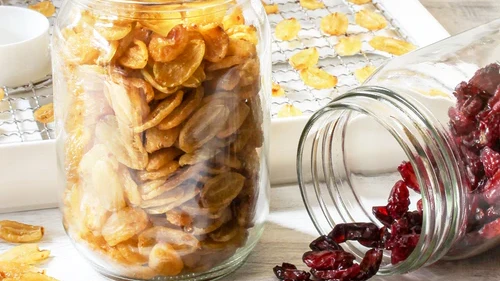Your Cart is Empty
Add description, images, menus and links to your mega menu
A column with no settings can be used as a spacer
Link to your collections, sales and even external links
Add up to five columns
Add description, images, menus and links to your mega menu
A column with no settings can be used as a spacer
Link to your collections, sales and even external links
Add up to five columns

Make your own raisins in a food dehydrator
Barb Hodgens
Barb Hodgens loves to cook with alternative, healthy whole food ingredients, with a focus on gut health. Barb has overcome her own gut health issues through healthy eating. Share your ideas, comments and photos at the end of this post :)

Sweet little morsels of dried deliciousness.
Grapes have become a popular backyard crop, but as with many seasonal fruits, they come in all at once and often there’s way too many to just eat fresh. Dehydrating is a great way to preserve your harvest. It takes a little prep and some patience but with the Breeze dehydrator you will master the process and find it fun and easy to do. You’ll absolutely love the results!
Drying grapes at home means you can explore the incredible range of flavours, textures and colour possibilities that aren’t available in commercial raisins. It’s also satisfying knowing they’re free from preservatives and have been dried at a temperature that won’t destroy any of the grapes nutrient filled goodness.

The flavour is truer to that of a fresh grape, only sweeter and more intense. They’re perfect little morsels to store in the pantry to satisfy a sudden sweet tooth. Use them in baked goods like these muffins, add them to Bircher muesli or granola, a hiking trail mix or toss them into salads for a burst of colour and sweetness.
The best choice for dehydration is seedless grapes, however some of the tastiest home-grown grapes, such as muscatels are full of seeds. With an extra step you can scoop them all out after slicing or just leave them in. Truth is, a large number of nutrients are contained in those pesky little seeds and once dehydrated they lose the bitterness and add a satisfying crunch.
The time it takes for grapes to dry varies significantly depending on the type and size of grape. It’s a good idea to check after about 18 hours and revisit as needed until they’ll done.



Make your own raisins in a food dehydrator
Luvele
Rated 5.0 stars by 1 users
Grapes have become a popular backyard crop, but as with many seasonal fruits, they come in all at once and often there’s way too many to just eat fresh. Dehydrating is a great way to preserve your harvest. It takes a little prep and some patience but with the Breeze dehydrator you will master the process and find it fun and easy to do. You’ll absolutely love the results!
Ingredients
Seedless grapes
Directions
- To remove dust and insects on the grapes, blanch by dropping by the bunch into boiling water for 30 seconds, then transfer into a bowl of very cold or ice water.
Lay the grapes on a clean tea towel and pat dry
Remove the grapes from the stems
Cut the grapes in half to speed the drying time.
Scoop out the seeds
Lay cut-side up in a single layer on the dehydrator trays or silicon sheets.
When you’re done set the Breeze dehydrator to 60°C for 18 hours. The grapes may take up to 30 hours depending on the size.
To test for readiness, take a few samples from the trays and let cool completely. Homemade dried raisins will be a little harder than store-bought ones. They should be leathery to the touch and click when you drop them on the bench-top. If you tear it, it shouldn’t be moist in the centre.
If you've dried your grapes too long and they are too hard, simply leave them out on the counter for a few of hours to reabsorb some moisture from the air9. Store home dried raisins in air-tight jars. If dried correctly they should last for up to 2 years.
Recipe Video
PIN THIS RECIPE

Make your own raisins in a food dehydrator

Sweet little morsels of dried deliciousness.
Grapes have become a popular backyard crop, but as with many seasonal fruits, they come in all at once and often there’s way too many to just eat fresh. Dehydrating is a great way to preserve your harvest. It takes a little prep and some patience but with the Breeze dehydrator you will master the process and find it fun and easy to do. You’ll absolutely love the results!
Drying grapes at home means you can explore the incredible range of flavours, textures and colour possibilities that aren’t available in commercial raisins. It’s also satisfying knowing they’re free from preservatives and have been dried at a temperature that won’t destroy any of the grapes nutrient filled goodness.

The flavour is truer to that of a fresh grape, only sweeter and more intense. They’re perfect little morsels to store in the pantry to satisfy a sudden sweet tooth. Use them in baked goods like these muffins, add them to Bircher muesli or granola, a hiking trail mix or toss them into salads for a burst of colour and sweetness.
The best choice for dehydration is seedless grapes, however some of the tastiest home-grown grapes, such as muscatels are full of seeds. With an extra step you can scoop them all out after slicing or just leave them in. Truth is, a large number of nutrients are contained in those pesky little seeds and once dehydrated they lose the bitterness and add a satisfying crunch.
The time it takes for grapes to dry varies significantly depending on the type and size of grape. It’s a good idea to check after about 18 hours and revisit as needed until they’ll done.


:recipekit:
PIN THIS RECIPE

Subscribe
Sign up to get weekly healthy recipes & information on new product releases.
Item is added to cart


